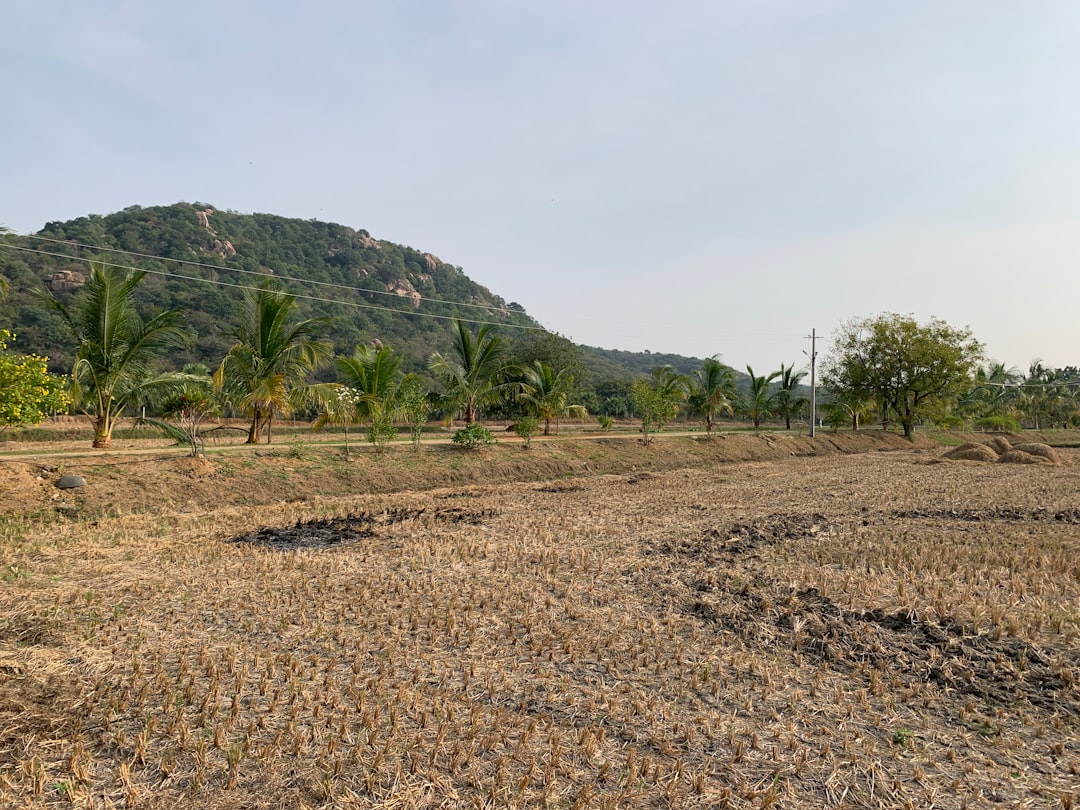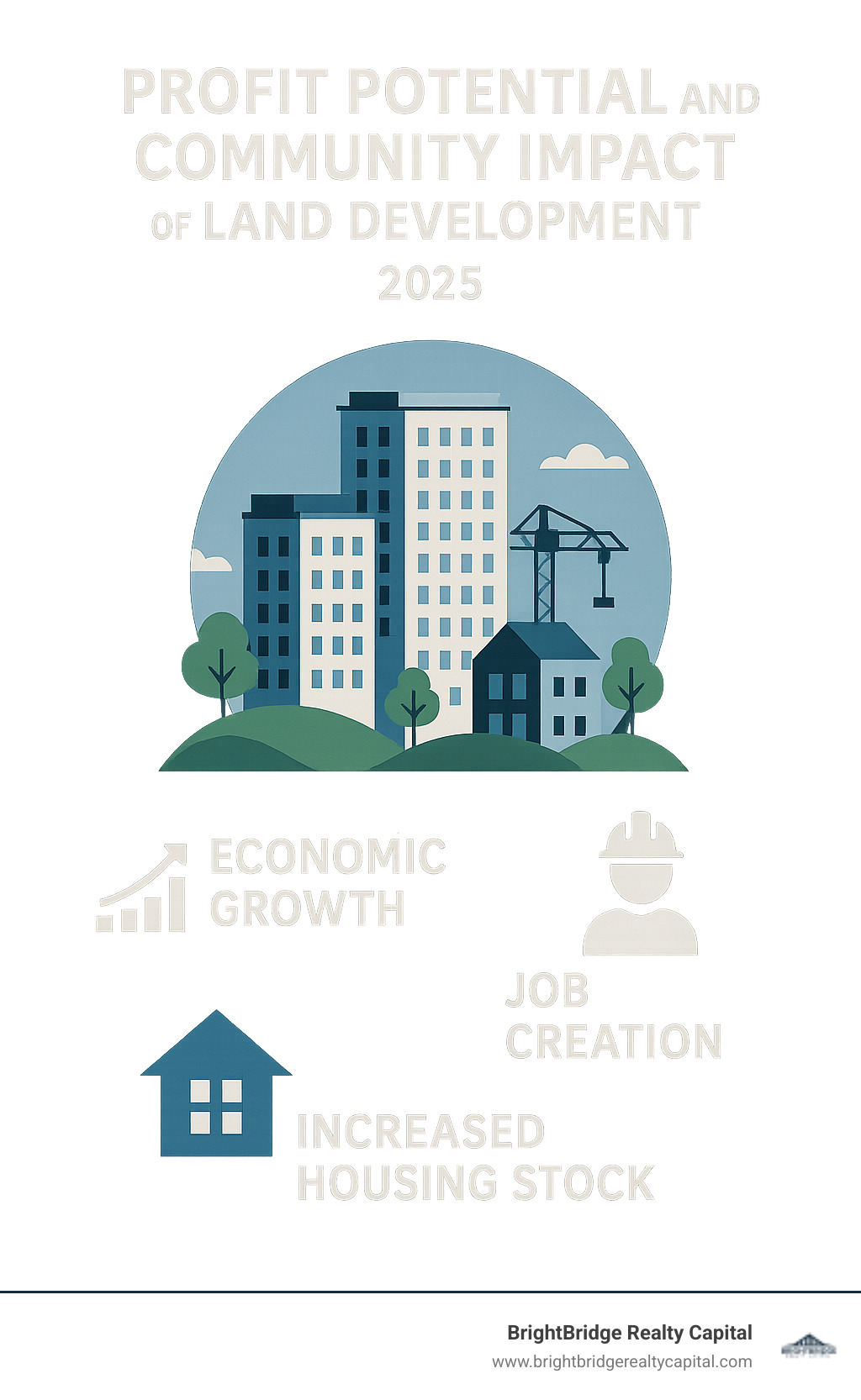From Dirt to Dollars: Navigating Land Development Financing

Why Land Development Loans Are Your Gateway to Real Estate Profits
Land development loans provide specialized financing to transform raw, underutilized land into profitable real estate projects. Unlike a standard mortgage, these are sophisticated financial instruments designed for a complex process involving acquisition, entitlements, infrastructure installation, and vertical construction. These short-term loans typically cover 50-75% of project costs with terms lasting 1-5 years, though they come with higher interest rates than traditional mortgages due to the increased risk inherent in creating value from the ground up.
Quick Answer for Investors:
- Loan Amount: 50-75% of total project costs (can be higher based on LTC).
- Terms: 1-5 years (short-term, designed to be refinanced or paid off upon project completion).
- Interest Rates: 4-10% (variable based on risk, experience, and market conditions).
- Down Payment: 20-50% required, demonstrating significant borrower equity.
- LTV Ratios: Typically 50-70% for land acquisition.
- LTC Ratios: Can reach up to 90% for the full development and construction phases.
- Primary Use: Land acquisition, site preparation (horizontal improvements), and infrastructure development.
Whether you're eyeing that prime lot for a fix-and-flip subdivision or planning a rental portfolio expansion through ground-up construction, land development financing bridges the gap between vision and reality. The challenge isn't just finding the money - it's finding the right financing structure that aligns with your specific timeline, budget, and profit goals. This requires a deep understanding of the financial metrics, application requirements, and lending partners that define the landscape.
Consider this scenario from our research: A developer identified a parcel of prime land in a rapidly expanding suburban corridor, perfect for a mixed-use development including residential units, office spaces, and retail establishments. With a comprehensive land development loan, the developer could acquire the land, conduct feasibility studies, navigate the complex entitlement process to obtain necessary permits, and begin construction on the infrastructure and buildings.
Most banks finance 60-80% of project costs, but often with a lengthy and rigid approval process. In contrast, private lenders often fund 25-50% of total development costs but offer unparalleled speed and flexibility. The key is understanding which financing type fits your specific project, risk tolerance, and timeline.
I'm Daniel Lopez, a loan officer at BrightBridge Realty Capital, where I've helped investors structure land development loans for everything from single-family subdivisions to complex mixed-use projects. My experience has shown me that the right financing partner doesn't just provide capital; they provide strategic guidance that can make the difference between a profitable development and a costly missed opportunity.

Land development loans basics:
Understanding the Financials: Key Terms and Loan Types
When diving into land development, understanding the financial lingo is crucial for turning your vision into a profitable reality. Land development loans aren't your typical home mortgage; they're specialized tools for specialized projects, each with its own set of metrics, risks, and rewards. Mastering these terms will empower you to negotiate better terms and structure deals that maximize your returns.
We'll break down essential terms like Loan-to-Value (LTV) and Loan-to-Cost (LTC), interest rates, loan terms, and what lenders look for in collateral. We’ll also touch on the critical difference between recourse and non-recourse loans. Knowing these terms will help you steer the financing landscape like a seasoned pro.
Key Features of Land Development Loans
Because you're transforming raw land into a valuable asset, there's more risk involved than with a standard property purchase. This elevated risk profile means these loans have unique features that both protect the lender and enable the developer.
- Loan Amounts: These loans are designed to cover a significant portion of your project's costs, from 50% to 75% of the land's purchase price, plus planning and construction expenses. For the land itself, you might see loans up to 75% LTV. For the full development, some aggressive loans can reach up to 90% of the total project cost (LTC).
- Typical Terms: Unlike a 30-year home mortgage, land development loans are short-term, usually lasting between one to five years. This is because the goal is to develop the land and then execute an exit strategy, such as selling the developed lots or completed buildings, or refinancing into a long-term commercial mortgage.
- Higher Interest Rates: Since developing raw land has more moving parts, potential delays, and market uncertainties, these loans often come with higher interest rates and fees, typically ranging from 4% to 10%. The final rate depends heavily on the market, your financial standing, your development experience, and the project's perceived risk.
- Collateral: The land you're developing is the primary collateral that secures the loan. Lenders will take a "first legal charge" or first-position lien on the property. Depending on the project's risk and the borrower's financial strength, they might also require additional collateral (like other real estate) or a personal guarantee.
Deep Dive into Key Financial Metrics
- Loan-to-Value (LTV) Ratios: For land development loans, LTV typically falls between 50% and 70%. This metric compares the loan amount to the appraised value of the land. For example, if your land is appraised at $1 million, a lender offering a 60% LTV will provide a loan of $600,000. The lower LTV compared to a standard mortgage reflects the speculative nature of undeveloped land.
- Loan-to-Cost (LTC) Ratios: While LTV looks at the land's current value, LTC is often more critical in development finance. It compares the loan amount to the total project cost—which includes land acquisition, hard costs (construction, materials), and soft costs (permits, architectural fees, legal fees). Some land development and servicing loans can go up to 90% loan-to-cost, especially when the lender is confident in the project's future value and the developer's track record. For a project with a total cost of $5 million, a 90% LTC loan would provide $4.5 million, requiring the developer to contribute $500,000 in equity.
- Recourse vs. Non-Recourse: This term defines the lender's rights in a default scenario. With a recourse loan, if the sale of the collateral (the property) is not enough to cover the outstanding debt, the lender can pursue your other personal or business assets to recoup their losses. This is common for less experienced developers or riskier projects. A non-recourse loan limits the lender's claim only to the collateral property itself. These are highly sought after by developers as they protect personal assets, but they are less common, more expensive, and typically reserved for experienced borrowers with strong projects and significant equity.
Beyond Interest Rates: Understanding Loan Fees
Your cost of capital extends beyond the interest rate. Be prepared for several fees:
- Origination Fees: An upfront fee charged by the lender for processing the loan, usually 1-3% of the total loan amount.
- Draw Fees: Since construction and development funds are disbursed in stages (draws), lenders may charge a flat fee for each draw request to cover inspection and administrative costs.
- Exit Fees: A fee charged when the loan is paid off, either through a sale or refinancing. This can be a percentage of the loan amount and is more common with private or hard money lenders.
- Prepayment Penalties: Some loans, particularly those from banks, may include penalties if you pay off the loan before a specified date, as the lender loses out on anticipated interest payments.
Common Types of Development Financing
Different project stages require different types of financing. Here’s a quick overview:
| Loan Type | Purpose | Typical LTV/LTC | Term | Key Use Cases |
|---|---|---|---|---|
| Land Acquisition Loan | To purchase undeveloped, raw land. | 50-75% LTV | Short-term (1-3 years) | Buying a vacant lot for future development, holding land for appreciation. |
| Horizontal Improvement Loan (Development Loan) | To fund site prep and infrastructure (roads, utilities). | Up to 90% LTC | Short-term (1-5 years) | Installing sewers, water lines, building access roads, grading land for building. |
| Ground-up Construction Loan | To finance the actual building of structures. | 60-80% of project cost | Medium-term (1-5 years) | Building residential homes, commercial buildings, or multi-family units from scratch. |
| Bridge Loan | Short-term, temporary financing. | Varies, often high LTV for quick access | Very short-term (6-24 months) | Bridging gap between land acquisition and permanent financing, or project completion and sale. |
Let's dive a little deeper into each type:
- Land Acquisition Loans: These are your first step, specifically for buying raw, untouched land. Because there is no income being generated and the future use is speculative, lenders view these as higher risk. They usually have a lower Loan-to-Value (LTV) and may require a clear, albeit preliminary, plan for the land's future development.
- Horizontal Improvement Loans (Development Loans): Once you own the land, it's time to get it ready for building. These loans fund all the "horizontal" or "underground" work: clearing the site, grading, putting in roads, and installing essential utilities like water, sewer, and electricity. These loans are crucial for transforming raw land into buildable, valuable lots.
- Ground-up Construction Loans: This is where you start to see things go "vertical." After the land is prepped, these loans finance the actual construction of homes, apartment buildings, or retail spaces. Funds are typically released in stages (draws) based on construction progress, which is verified by an inspector.
- Bridge Loans: These are short-term loans designed to "bridge" a financial gap. For example, you might use a bridge loan to quickly acquire a property at auction before you have time to secure a longer-term development loan. Or, you might use one to finish a project and cover operating costs while you wait for it to sell or for permanent financing to be put in place. They prioritize speed over cost.
Often, lenders offer combined Acquisition & Development (A&D) Loans. These comprehensive packages cover both buying the land and the initial horizontal improvements, streamlining the financing process for larger, multi-stage projects and reducing closing costs.
The Application Blueprint: How to Secure Land Development Loans
Getting approved for land development loans is like building a house - you need a solid foundation and a detailed blueprint before you can even think about breaking ground. Unlike walking into a bank for a car loan, securing development financing is a rigorous process that requires a strategic, evidence-based approach. The good news? When you know exactly what lenders are looking for, the process becomes a clear roadmap rather than an intimidating maze.
Preparing for Your Application: The Pre-Approval Homework
Think of this phase as your project's dress rehearsal. You wouldn't perform on stage without practicing first, and you shouldn't approach lenders without a bulletproof case. The developers who get approved quickly and on favorable terms are the ones who can prove their project makes financial sense from every conceivable angle.
1. In-Depth Market Research: This forms the backbone of your application. You need to demonstrate undeniable demand for what you're planning to build. Go beyond simple assumptions. * Data Sources: Utilize the Multiple Listing Service (MLS) for comparable sales (comps), city planning departments for future development plans, and local economic development corporations for data on job growth and population trends. * Key Metrics: Analyze absorption rates (how quickly homes are selling), average days on market, and pricing trends for similar properties. Is the market supply-constrained? Is demand growing? * Competitor Analysis: Identify competing projects, their pricing, features, and sales velocity. How will your project differentiate itself and capture market share?
2. The Feasibility Study: This is the financial soul of your project. This detailed analysis breaks down every number to tell the complete story. * Financial Analysis: Create a detailed pro forma financial model showing all projected revenues and costs. This must include: * Hard Costs: Direct construction expenses like labor, materials, site work, and utilities. * Soft Costs: Indirect expenses like architectural and engineering fees, permits, legal fees, insurance, marketing costs, and loan interest. * Contingency Fund: A crucial line item, typically 5-15% of total project costs, to cover unexpected delays and expenses. Lenders need to see this. * Site Analysis: Evaluate the physical characteristics of the land, including topography, soil conditions (geotechnical report), and access to utilities. * Legal & Regulatory Analysis: Confirm the project's viability within current zoning and land use regulations.
3. A Comprehensive Business Plan: This document brings everything together into one compelling narrative. It should be professional, detailed, and persuasive, outlining your vision, development strategy, realistic timelines, and detailed financial projections. It demonstrates your understanding of the entire development lifecycle and showcases your team's capabilities. Most importantly, it must clearly present your exit strategy.
4. Zoning, Entitlements, and Permits: This can make or break your project before you even start. You must ensure your proposed development aligns with local zoning regulations. The process of getting entitlements (the legal right to develop a property for a specific use) can be long and costly. * Navigating the Process: Understand if you need a zoning variance, a conditional use permit, or a full rezoning. This often requires public hearings and can face community opposition. Lenders want to see that you have a clear path through this process, ideally with the help of an experienced land-use attorney. The complex landscape of development projects requires careful navigation, and lenders want to see you've done this homework.
5. A Clear Exit Strategy: This answers the lender's most important question: "How do we get our money back?" Your plan must be specific and backed by your market research. Are you planning to sell completed lots to builders? Sell finished homes or condo units to individual buyers? Or refinance into a long-term, income-producing loan once the property is stabilized? A vague exit strategy is a major red flag.
Essential Documentation and Borrower Qualifications
Once your project planning is solid, it's time to gather the paperwork that proves you can execute your vision. Land development loans require extensive documentation because lenders are underwriting the project's viability and your ability to manage it.

- Personal and Business Financial Statements: Lenders need to see balance sheets, income statements, and cash flow statements for both you personally and your development entity (LLC, etc.). They are assessing your net worth and, critically, your liquidity (cash on hand).
- Tax Returns: Typically, two to three years of personal and business tax returns are required to verify income and financial stability.
- Project Plans and Blueprints: Detailed architectural plans, site plans, and engineering reports that show exactly what you're planning to build.
- Appraisals: You will need a professional appraisal of the land "as-is" and an "as-completed" appraisal projecting the value of the finished project. This is fundamental to the lender's risk assessment.
- Contractor Bids and Budgets: A detailed, line-item budget from a reputable general contractor. This validates your hard cost projections.
- Environmental Reports: A Phase I Environmental Site Assessment (ESA) is standard. It assesses the land for potential contamination. If issues are found, a more invasive Phase II ESA may be required. Lenders will not finance contaminated land without a clear remediation plan.
- Surveys: A boundary survey is the minimum. Often, an ALTA/NSPS Land Title Survey is required, which is a more comprehensive survey that includes boundaries, easements, encroachments, and other critical information.
- Resumes and Experience Documentation: Provide detailed resumes for you and your key team members (architect, engineer, general contractor). Lenders prioritize borrowers with a proven track record in development. If you are new, show that you have partnered with experienced professionals.
- Proof of Equity Contribution: Evidence of the cash you are injecting into the project, demonstrating your financial commitment.
Your credit score and financial history significantly impact your ability to secure favorable terms. Most lenders require a credit score of at least 680, with scores above 720 receiving the best rates. Lenders will scrutinize your financial history for consistent income, manageable debt-to-income ratios, and a track record of responsible borrowing. Your liquidity is especially important, as lenders want to see you have cash reserves to handle unexpected costs.
If you have past bankruptcies or foreclosures, securing traditional financing can be challenging. However, some private lenders focus more on the project's viability and your equity contribution rather than just past credit issues.
The application process typically moves through several stages: initial document submission, lender due diligence and underwriting, issuance of a term sheet or letter of intent, and finally, closing. The approval timeline can range from a few weeks to a couple of months, depending on your project's complexity and the lender's efficiency. At BrightBridge Realty Capital, we specialize in faster closings, often within a week, because we understand that timing is crucial in development projects.
Weighing the Pros, Cons, and Partners
Securing land development loans is a high-stakes endeavor that comes with both exciting opportunities and significant potential pitfalls. A clear-eyed assessment of the risks and rewards, coupled with a strategic choice of lending partner, is essential before making any major commitments.
Advantages and Disadvantages
The Upside: Why Developers Take the Risk
The high-yield potential is the primary driver for land development. When you successfully transform raw land into buildable lots or completed structures, you are creating substantial value from scratch. The profit margins can be immense, often far exceeding those of buying existing properties. For example, buying a parcel for $500,000, investing $1 million in development, and selling the resulting lots for $2.5 million can generate a $1 million profit.
Beyond financial returns, there's immense satisfaction in value creation through community development. You're not just making money; you're building neighborhoods, creating spaces for businesses to thrive, and contributing to local economic growth and housing supply.
Land development loans also offer remarkable project flexibility. Since funds are typically disbursed based on milestones (the draw process), you can manage cash flow effectively. This structure allows you to adjust your timeline and approach as market conditions change, potentially slowing down during a downturn or accelerating when demand is hot.
Finally, there can be significant tax advantages. Interest paid on the loan is typically a deductible business expense. Furthermore, you can depreciate the improvements made to the land, creating tax shelters for your income.
The Downside: Acknowledging the Inherent Risks
It's crucial to be realistic about the risks involved.
- Market Risk: This is the risk that the market turns against you. An economic recession, rising interest rates, or a shift in local housing demand can erode your projected profits or make it difficult to sell your finished product.
- Entitlement Risk: This is one of the biggest hurdles. You might spend significant time and money trying to get the necessary zoning changes and permits, only to be denied by the local municipality. This can halt a project before it even begins.
- Construction Risk: Projects are frequently plagued by unforeseen issues. Material costs can spike due to supply chain disruptions, labor shortages can cause delays, and disputes with contractors can lead to costly litigation. A solid contingency budget is your best defense here.
- Complexity and Management Overhead: The complexity of land development can be overwhelming, especially for newcomers. You are the conductor of an orchestra of engineers, architects, contractors, city planners, environmental consultants, and real estate agents—all while managing cash flow and the bottom line.
- Higher Financing Costs: The higher interest rates and fees associated with land development loans mean the clock is always ticking. Every month of delay adds to your carrying costs and eats into your profit margin.
Choosing the Right Lending Partner
Finding the right lender is one of the most critical decisions you'll make. The wrong choice can derail your project with delays and inflexibility, while the right one becomes a trusted strategic partner.
- Traditional Banks: Banks and large financial institutions typically finance 60-80% of project costs and offer the lowest interest rates. However, their approval processes are notoriously thorough and slow, their requirements are strict, and they tend to be very conservative, often avoiding projects with any hair on them. They are best for experienced developers with straightforward projects and plenty of time.
- Private Lenders: Private money lenders, like BrightBridge Realty Capital, operate differently. We often fund 25-50% of total development costs, and our interest rates might be higher—typically ranging from 6-15%. In return, you get unparalleled speed, flexibility, and a willingness to look at the merits of a deal that a bank might reject. We focus more on the project's viability and collateral rather than just a borrower's credit history.
- Credit Unions: As community-focused institutions, credit unions can be a good middle ground. They may offer competitive rates, sometimes better than banks, and might provide flexible features like interest-only payments during the construction phase to help with cash flow.
- Hard Money Lenders: These are a subset of private lenders that focus almost exclusively on the asset (the property) and offer the fastest funding. Their rates and fees are the highest, but for a developer who needs to close on a deal in days, not months, they can be an invaluable tool.
- Seller Financing: In some cases, the person selling the land may be willing to finance a portion of the purchase price. This can be a creative way to reduce your upfront cash requirement and can often be combined with a traditional or private loan.
When evaluating potential lenders, experience matters tremendously. You want a partner who understands that development projects rarely go exactly to plan. Ask them how they've handled past projects that faced delays or cost overruns. A lender with deep development experience is a valuable advisor, not just a source of funds.
Reputation is equally important. Ask for references from other developers. Who delivered on their promises? Who was supportive when problems arose? A lender's reputation for closing on time and as promised is paramount.
Don't just compare interest rates; look at the complete package, including LTV/LTC ratios, all associated fees, prepayment penalties, and the flexibility of the draw schedule. Sometimes a slightly higher rate with better terms is the smarter long-term choice.
Speed and flexibility can make or break a deal. Real estate opportunities don't wait for slow approvals. At BrightBridge Realty Capital, we've built our reputation on fast closings—often within a week—and direct lending without intermediaries. We understand that in development, timing is everything, and our streamlined process helps investors capitalize on opportunities quickly, especially in fast-moving markets like New York.
Frequently Asked Questions about Land Development Loans
Here are detailed answers to the most common questions developers have when exploring their financing options for land projects.
How much down payment is required for a land development loan?
Land development loans require a larger upfront investment than a typical home mortgage, reflecting the higher risk. Expect to provide a down payment, or equity injection, of 20% to 50% of your total project cost.
The exact percentage depends heavily on the project's risk profile. For instance, buying raw, unentitled land is the riskiest stage, so a lender will want more "skin in the game" from you, often pushing the down payment requirement closer to 40-50%. If you are acquiring land that is already zoned and "permit-ready," the risk is lower, and the down payment might be closer to 25-30%.
Your track record is also crucial. An experienced developer with a strong balance sheet and a portfolio of successful projects can often negotiate a lower down payment, sometimes in the 20-25% range. New developers should expect lenders to ask for a minimum of 30-40%.
Many private lenders require at least 30% down for acquisition and development loans. Remember, a larger down payment reduces the lender's risk, which often translates to better loan terms and a lower interest rate for you.
What is the average interest rate on a land development loan?
Interest rates on land development loans typically fall between 4% and 10% for traditional lenders and 6% to 15% for private or hard money lenders. These rates reflect the inherent risk of development, as lenders are betting on your vision for what raw land will become.
Several factors influence your rate:
- Your Experience and Financials: A strong credit score (above 720), significant liquidity, and a proven track record will help you secure rates on the lower end of the spectrum.
- Project Risk: A fully entitled project in a hot market is less risky and will command a better rate than a speculative land purchase with zoning hurdles.
- Lender Type: Banks and credit unions generally offer the lowest rates but have the strictest requirements. Private lenders charge higher rates in exchange for speed, flexibility, and the ability to fund deals banks won't touch.
Remember to account for additional costs beyond interest, such as origination fees (1-3%), draw fees, and potential exit fees. Always ask for a term sheet that provides a complete breakdown of all costs to understand your true cost of capital.
How long does it take to get approved for a land development loan?
The approval timeline can range from a few days to several months, and this difference often determines whether you can secure a time-sensitive property.
- Traditional Banks: Known for being thorough but slow. Their multi-layered committee approval processes can easily take 60 to 90 days or more. Development opportunities don't usually wait that long.
- Private Lenders: Direct lenders like BrightBridge can move much faster because they have streamlined underwriting and decision-making processes. We have closed land development loans in as little as a week when a borrower comes prepared with all necessary documentation.
To ensure a speedy process, you must be organized. Have your complete package ready—feasibility study, market analysis, pro forma, financial statements, and project plans—before you approach lenders. Developers who get approved quickly treat the application as a professional business proposal, not a casual request.
How are funds disbursed on a land development loan?
Funds are not given as a lump sum. They are disbursed in stages, known as draws, based on the completion of specific project milestones. The process typically works like this:
- Initial Draw: The first draw at closing may cover the land acquisition cost.
- Development Draws: As you need funds for horizontal improvements (like grading or utility installation), you submit a draw request to the lender.
- Inspection: The lender sends an inspector to the site to verify that the work claimed in the draw request has been completed satisfactorily.
- Funding: Once the inspection is approved, the lender releases the funds for that portion of the work.This process protects both the borrower and the lender by ensuring that loan proceeds are used as intended and that the project is progressing according to plan.
What are the most common mistakes to avoid when applying?
- Incomplete Due Diligence: Failing to thoroughly investigate zoning, environmental issues, or utility access before going under contract.
- Unrealistic Budget: Underestimating costs or failing to include a sufficient contingency fund (10-15% is standard). Lenders will dissect your budget, and an unrealistic one kills credibility.
- Weak Exit Strategy: Not having a clear, data-backed plan for how you will repay the loan.
- Poor Presentation: Submitting a disorganized or incomplete loan package. This signals to the lender that you may be disorganized in managing the project itself.
What happens if the project goes over budget or is delayed?
This is where your contingency fund and your relationship with the lender are critical. If you anticipate a cost overrun, communicate with your lender immediately and transparently. If your contingency is sufficient, you can use it to cover the extra costs. If the overrun exceeds your contingency, you may need to contribute more of your own equity or request an increase in the loan amount, which the lender may or may not approve. Delays increase carrying costs (interest payments), so it's vital to have a realistic timeline and a lender who understands that delays can happen and is willing to work with you on solutions.
Conclusion
Navigating the world of land development loans might feel like reading a complex blueprint at first. But, as we've explored in detail, with the right knowledge, meticulous preparation, and a clear plan, it becomes an incredibly powerful tool. It's truly your gateway to unlocking the immense potential hidden in undeveloped land, transforming dirt into dollars and vision into reality.
We've covered a comprehensive landscape: from the fundamental financial metrics like LTV and LTC to the nuances of recourse loans and associated fees. We've walked through the rigorous application process, highlighting the critical importance of in-depth market research, a bulletproof feasibility study, and a well-defined exit strategy. We've also weighed the substantial advantages, such as high-yield potential and community building, against the very real risks of market shifts, entitlement battles, and construction challenges.
The success of your land development project doesn't just hinge on a great vision or perfect execution; it is fundamentally dependent on a smart, agile, and well-structured financial strategy. By truly understanding the loan terms, preparing your application with professional diligence, and choosing a lending partner who is an expert in development finance, you can confidently turn raw land into vibrant communities and highly profitable ventures.
At BrightBridge Realty Capital, we’re passionate about helping developers like you bring their ambitions to life. We understand the specific challenges, the tight timelines, and the incredible opportunities that come with land development. That's why we're here to offer the quick, flexible, and reliable funding solutions you need to keep your projects moving forward without costly delays. Don't let financing be the hurdle that keeps your vision stuck as a blueprint.
Ready to turn your dirt into dollars? Let's build something great together. Explore your ground-up construction financing options with us today.





